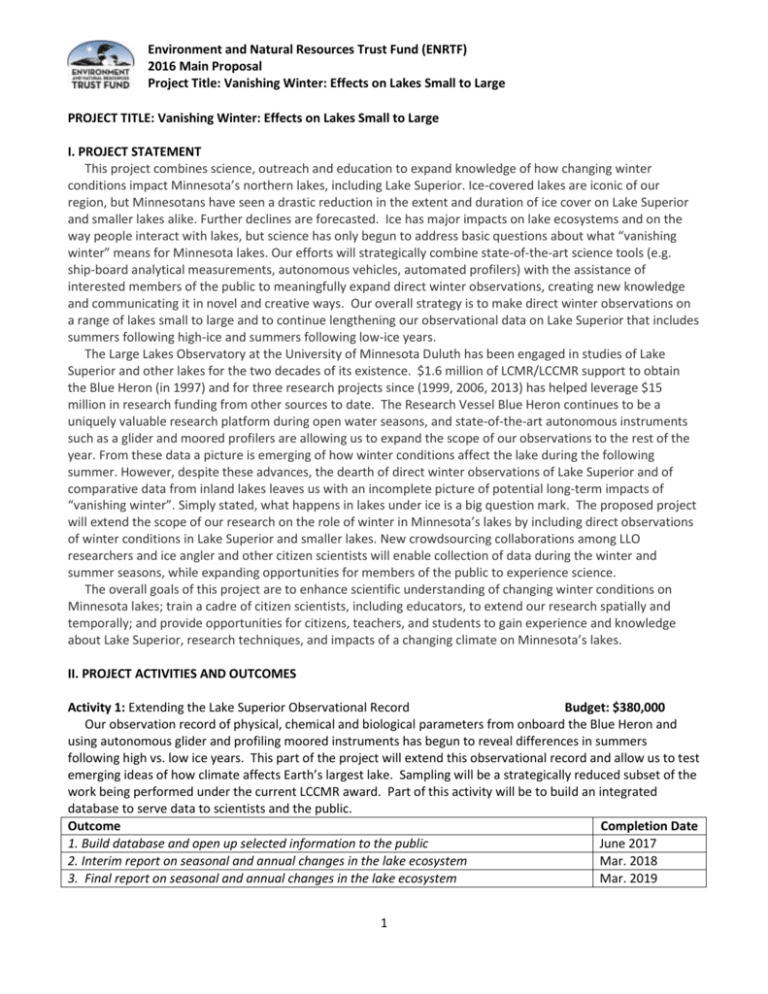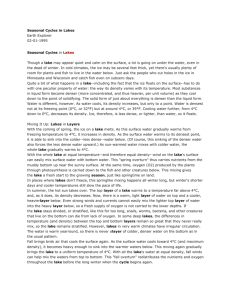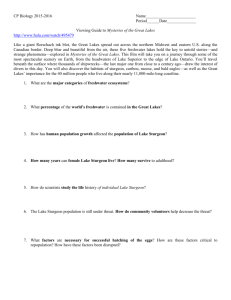Main Proposal - Minnesota Senate
advertisement

Environment and Natural Resources Trust Fund (ENRTF) 2016 Main Proposal Project Title: Vanishing Winter: Effects on Lakes Small to Large PROJECT TITLE: Vanishing Winter: Effects on Lakes Small to Large I. PROJECT STATEMENT This project combines science, outreach and education to expand knowledge of how changing winter conditions impact Minnesota’s northern lakes, including Lake Superior. Ice-covered lakes are iconic of our region, but Minnesotans have seen a drastic reduction in the extent and duration of ice cover on Lake Superior and smaller lakes alike. Further declines are forecasted. Ice has major impacts on lake ecosystems and on the way people interact with lakes, but science has only begun to address basic questions about what “vanishing winter” means for Minnesota lakes. Our efforts will strategically combine state-of-the-art science tools (e.g. ship-board analytical measurements, autonomous vehicles, automated profilers) with the assistance of interested members of the public to meaningfully expand direct winter observations, creating new knowledge and communicating it in novel and creative ways. Our overall strategy is to make direct winter observations on a range of lakes small to large and to continue lengthening our observational data on Lake Superior that includes summers following high-ice and summers following low-ice years. The Large Lakes Observatory at the University of Minnesota Duluth has been engaged in studies of Lake Superior and other lakes for the two decades of its existence. $1.6 million of LCMR/LCCMR support to obtain the Blue Heron (in 1997) and for three research projects since (1999, 2006, 2013) has helped leverage $15 million in research funding from other sources to date. The Research Vessel Blue Heron continues to be a uniquely valuable research platform during open water seasons, and state-of-the-art autonomous instruments such as a glider and moored profilers are allowing us to expand the scope of our observations to the rest of the year. From these data a picture is emerging of how winter conditions affect the lake during the following summer. However, despite these advances, the dearth of direct winter observations of Lake Superior and of comparative data from inland lakes leaves us with an incomplete picture of potential long-term impacts of “vanishing winter”. Simply stated, what happens in lakes under ice is a big question mark. The proposed project will extend the scope of our research on the role of winter in Minnesota’s lakes by including direct observations of winter conditions in Lake Superior and smaller lakes. New crowdsourcing collaborations among LLO researchers and ice angler and other citizen scientists will enable collection of data during the winter and summer seasons, while expanding opportunities for members of the public to experience science. The overall goals of this project are to enhance scientific understanding of changing winter conditions on Minnesota lakes; train a cadre of citizen scientists, including educators, to extend our research spatially and temporally; and provide opportunities for citizens, teachers, and students to gain experience and knowledge about Lake Superior, research techniques, and impacts of a changing climate on Minnesota’s lakes. II. PROJECT ACTIVITIES AND OUTCOMES Activity 1: Extending the Lake Superior Observational Record Budget: $380,000 Our observation record of physical, chemical and biological parameters from onboard the Blue Heron and using autonomous glider and profiling moored instruments has begun to reveal differences in summers following high vs. low ice years. This part of the project will extend this observational record and allow us to test emerging ideas of how climate affects Earth’s largest lake. Sampling will be a strategically reduced subset of the work being performed under the current LCCMR award. Part of this activity will be to build an integrated database to serve data to scientists and the public. Outcome Completion Date 1. Build database and open up selected information to the public June 2017 2. Interim report on seasonal and annual changes in the lake ecosystem Mar. 2018 3. Final report on seasonal and annual changes in the lake ecosystem Mar. 2019 1 Environment and Natural Resources Trust Fund (ENRTF) 2016 Main Proposal Project Title: Vanishing Winter: Effects on Lakes Small to Large Activity 2: “LLO Science on Deck” up the shore Budget: $100,000 Knowledge that is generated is of little utility unless communicated. We will expand our popular “Science Friday” public outreach events, now to be called “LLO Science on Deck,” to communities along the Minnesota North Shore, sharing knowledge and connecting scientists with the public. Outcome Completion Date 1. Science on Deck at Duluth, Two Harbors, Beaver Bay, Grand Marais Fall 2017, 2018 2. Public and/or Citizen Scientist tours of the R/V Blue Heron Fall 2017, 2018 Activity 3: Citizen Science Program Budget: $120,000 This part of the project extends our reach by enlisting citizen scientists in data collection. Avid ice anglers, teachers, and lake home-owners will be recruited and trained to collect summer and winter research quality data from selected lakes. Volunteers will be trained by scientists and they will experience Lake Superior research on the R/V Blue Heron, to be further exposed to analysis, interpretation, and visualization of research results. Outcome Completion Date 1. Citizen/teacher/student data collection Jan 2018 & 2019 2. Citizen/teacher participation on the RV Blue Heron Fall 2017 & 2018 3. Online- dissemination of data and analyses to participants, agencies, and the public Jul 2017 & ongoing III. PROJECT STRATEGY A. Project Team/Partners Requesting Trust Fund support: U of M Duluth LLO: Robert Sterner (project management, biological productivity; data management); Jay Austin (lake circulation); Erik Brown (carbon & nutrient cycling); Sergei Katsev (water-sediment interactions); Elizabeth Minor (carbon & nutrient cycling); Ted Ozersky (under-ice biology; food webs); Richard Ricketts (ship operations; logistics); Kathryn Schreiner (carbon cycling). UMD MN Sea Grant: Cynthia Hagley (Citizen Scientist Program). UMD Biology: Donn Branstrator (zooplankton ecology); Tom Hrabik (fish ecology). UMD NRRI: Richard Axler (data dissemination; on-line data visualization). B. Project Impact and Long-Term Strategy Our goal is to understand seasonal responses of lake systems, including Lake Superior’s, under changing climatic conditions. Information collected will be especially useful when integrated with work of other organizations including: USEPA, MNDNR, MPCA, USGS, Lake Superior National Estuarine Research Reserve. We will extend long-term datasets resulting from earlier work supported by NSF, MN Sea Grant and LCCMR. Lengthening our observational record will add great value to the existing data and make us more competitive when seeking funding from other sources. Integration of citizen science into the project will expand our research temporally and spatially and increase citizen understanding and stewardship of Minnesota’s lakes. C. Timeline Requirements Three years of funding (July 2016 through June 2019) will allow work on the lake over two full field seasons (2017 and 2018) with supplemental observations in 2016 to assure continuity in our datasets. 2









